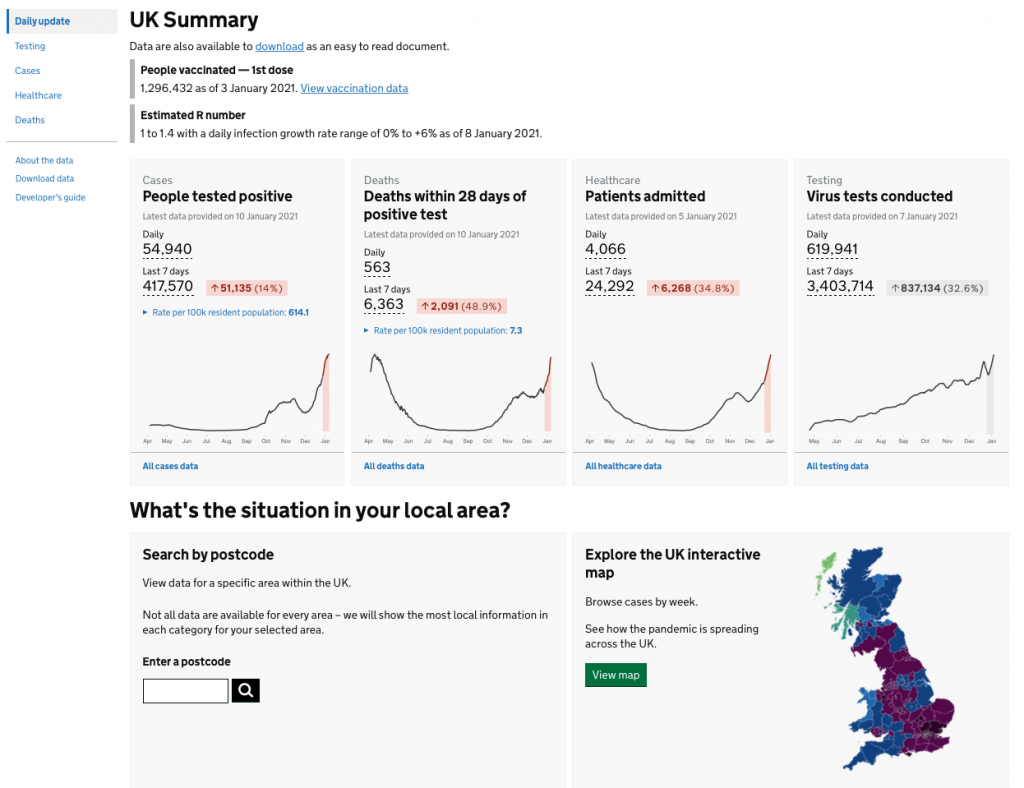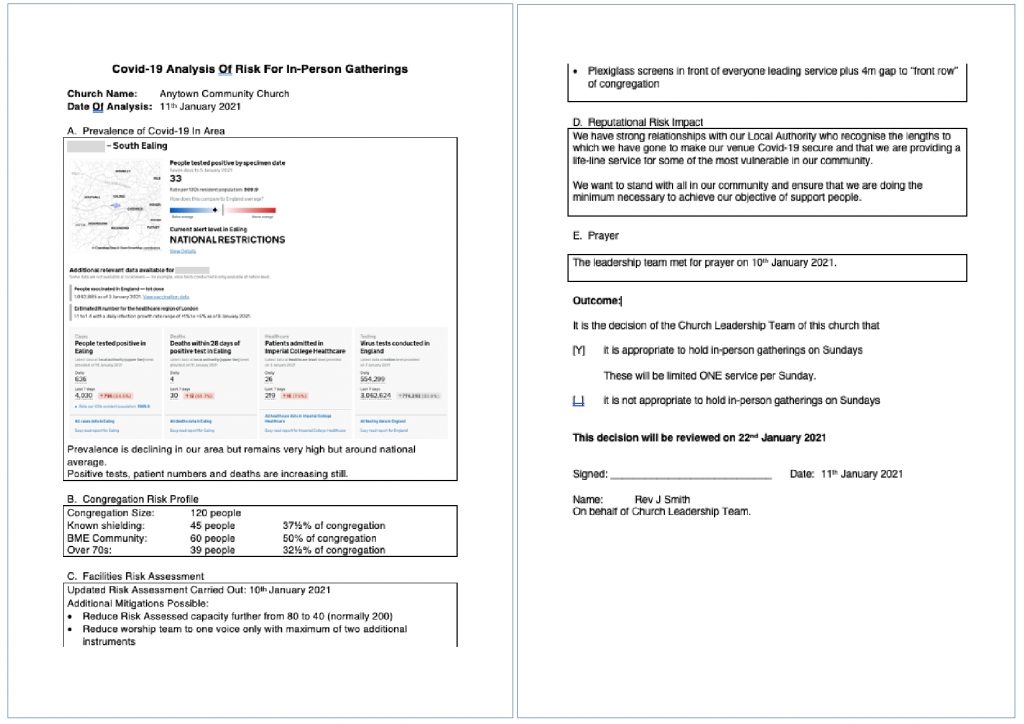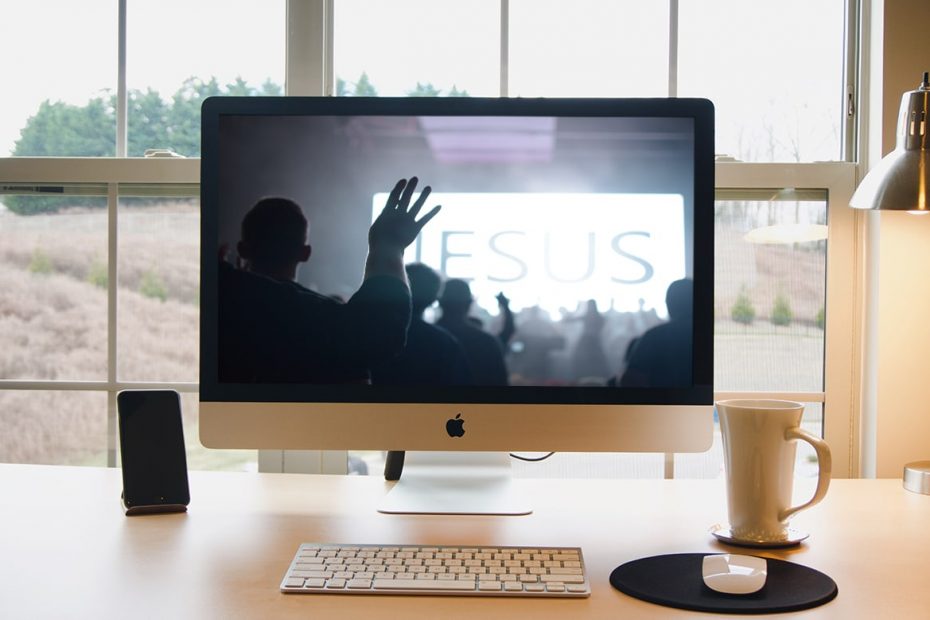During previous lockdowns in the UK, some church leaders expressed frustration that the Governments decided whether church buildings could stay open or not. During the current lockdowns which have greeted us as we start 2021, the Governments (with the exception of the Scottish Government) have given us the freedom we wanted and are allowing churches and other places of worship to remain open. However, this may turn out to be a far more difficult position than the simple one we were previously faced with as now we, as church leaders, need to make the decision on whether to open for in-person worship or to move services online, whether prerecorded or broadcast live from the building. That is a really challenging decision for many, with some local authorities in parts of England asking churches to use their freedom and choose to close and other parts of the church community saying that we must remain open. Danny Webster of the Evangelical Alliance wrote an excellent blog on “To Meet Or Not To Meet” which I would advise every to read before reading this blog as it provides the context for what I am about to write. Having read Danny’s blog, I thought it would be really helpful to provide some practical tools which may help you in your decision making with your church leadership and also could provide a basis for simple documentation of your decision-making which could provide reassurance to others (denomination, local authority, congregation members) that your decisions have been made robustly and with a recognition of all of the risks involved. For a brilliant example of one church’s decision making read this article (“The Gov says church buildings can open. But we’ve decided to close”) by Carl Beech for Premier Christianity Magazine.
As an initial comment, it is my opinion that if you are in the most severe ‘normal’ level of restriction (which would be Tier 4 (England), Alert Level 4 (Wales), Level 4 (Scotland), Level 5 (Republic of Ireland)) or a National Lockdown and permission is given for places of worship to remain open for public worship, then you should take this to mean Sunday Service(s) and no other church ‘spiritual gathering’ such as prayer meetings, bible studies, home groups etc. When so many other parts of society are being significantly restricted, it seems inappropriate for churches to have gatherings throughout the week. To also make clear, my advice for all nations of the UK is that any restrictions do not cover voluntary/public services (such as Foodbanks), essential support groups (the guidance for England gives examples of the types of group, which would be reasonable for all of the UK nations), funerals, essential weddings, formal childcare provision etc.
Therefore, what things should you look at and do in making your decision on whether to have in-person Sunday gatherings
1. Pray
It would be wrong of me to not have this as the first and most important decision-making step for every one of us. It would be very easy to get overwhelmed by statistics, data, expectations, and pressures but, as church leaders, we need our priority to be coming before God and seeking His thoughts and direction on this matter. However, let us also remember that what we feel we may have heard from God might be different from others and our decision is not “the will of God” for everyone. Different people, even in the same geographical area, will make different decisions. We need to show each other grace and love.
2. Prevalence of Covid-19 in your area
One of the key pieces of external data you need to make a decision on in-public gatherings is the prevalence of the virus in your area. Fortunately for those in the UK have access to up to date data from the UK Government. If you go to coronavirus.data.gov.uk you find useful data on the case rate, hospital admissions, testing, vaccinations etc.

As you can see from this screenshot, in addition to the national data, it is really useful that you can access data at a local level, by either entering your postcode or exploring an interactive map. The amount of data varies depending upon which of the devolved nations you are part of. For England, the data is provided down to a really small area (Lower Layer Super Output Areas or LSOAs), whereas for Wales, Scotland and Northern Ireland, it is to Local Authority area. Whichever it is, however, this will still give you really useful local information. You can use a range of this data but my advice would be to review the following key information:
- Rate per 100k resident population (and how this has changed from previous data – you can see this on the map version and moving the slider above the map)
- Where this rate shows against the national average (the blue to red graph)
- Patients admitted to the local hospital (and whether this is up or down on the last set of data)
- Estimated ‘R’ rate for the region (how close to 1.0 or below it is)
These key pieces of data are the ones which will show you how prevalent the virus is across your area. It should be read in the context of the national levels and whether the rates of the virus are increasing or decreasing in your area. The UK Government website helpfully colour codes the levels in terms of seriousness and this will help you understand the situation. Therefore, the principles you are looking at are:
- Is the rate per 100k above, well above or significantly above the national average?
- Is the rate in the area growing or decline (whether that rate is high or low)?
- Are local hospitals under sustained pressure?
This type of data will help you understand how prevalent the virus is in your area. You should also take serious note if the levels of Covid-19 are so serious in your area that your local authority is asking places of worship to consider refraining from your permission to hold in-person gatherings.
3. Profile Of Congregation
This should be information that you currently hold within your church and is the recognition that whilst everyone is at high risk from coronavirus, there are others who are recognised as being at particular risk. It is important, in your decision making, whether holding in-person gatherings will have a particular impact on certain sections of your congregation and whether this should influence your decision making. These categories include:
- Those who are ‘shielding’ because they are clinically extremely vulnerable to Covid-19. It would seem unwise for these individuals to be encouraged to attend church in person at present as they are being asked to be even more cautious than the rest of the population.
- Those who are from a Black and Minority Ethnic (BME) community.
- Those who are aged 70 or over.
- Those who are at moderate risk of coronavirus and so would not get a ‘shielding’ letter from the NHS. This list of those conditions can be found on the NHS website by clicking here.
Whilst some of these groups are easier to identify than others, you should be able to do at least a rough estimate of who is impacted by these risks. If you come to an assessment that 80% of your congregation falls into these categories, then it may well influence your decision on whether to hold in-person gatherings. Compare this with if you only have 10% of people in these categories.
The flip-side of this analysis is that you should make an assessment of the number/percentage of your congregation who are vulnerable or alone and for whom congregational worship is the one chance they have for social interaction because they may not have the technology to Zoom/Facetime etc. We should not forget that corporate worship gatherings have provided a lifeline to many people and it would be wrong to only focus on the risks associated with bring people into the building. We should also assess the risk of not bringing some people into the building.
4. Updated Risk Assessment with Additional Mitigations
You should already have a Risk Assessment in place which has been updated regularly during the pandemic (if yours is still dated 4th July 2020, it is wildly out of date and you are not meeting the requirements on Risk Assessments – do go back and reread my blog on undertaking Risk Assessments here).
If you have undertaken steps 2 and 3 above and think that you may want to continue in-person gatherings then you should your next stop is your Risk Assessment.
Given the emergence of the new, much more transmissible, strain of Covid-19 and the levels of prevalence in communities, you should review your Risk Assessment and decide whether there are additional steps (or mitigations) you can take to reduce the risk even further. Additional steps you may want to consider are:
- Further reduce the capacity of your building to ensure risk of transmission takes into account the new more transmissible variant. This really ought to be one that everyone considers and implements.
- Restrict the number of services you hold on a Sunday and if you do feel you should have more than one gathering, to increase the gap between services.
- Reduce the number of people involved in leading the service and ensure that additional mitigations are in place for them (plexiglass screens between and in front of singers).
- Be more strict on asking the Covid-19 questions (temperature, cough, smell/taste) and enforcing the rules of hands (sanitising regularly), face (wearing a face covering at all times), and space (ensuring 2m distance at all times).
- Ventilation. It has become increasingly clear from scientific evidence that coronavirus is transmitted very easily in aerosol, in other words in the air. It had previously been thought that the main means of transmission was in droplets of liquid projected from the mouth or nose, which are much heavier and fall to the ground relatively quickly. In contrast, aerosols will hang in the air for some significant time and will float around a room. It has, therefore, become one of the primary risk mitigations to ensure that you have as much ventilation in a room as possible. If no ventilation is possible at all, then this is a high-risk location and should be avoided. The more ventilation you can get, the better. You should open all doors and windows for about 30 minutes before a service and should ideally keep them open during the service and only close them once the building is empty. If you must close doors during a service (due to noise restrictions for neighbours for example) then you should still open them at least once during a one-hour service. During the winter this will mean that your building will be cold and you should warn your congregation of this and that they should wrap up warm. Ventilation should be at the top of your risk prevention actions now.
If, when you first reopened your building, you felt that you could only just get through your Risk Assessment and you don’t feel you can add additional mitigations, then it may be that you cannot continue in-person gatherings due to the increased risk caused by your building.
I also recognise in this that for some churches your decision on in-person gatherings will be taken for you because you do not have your own building and rely on hiring a facility. Whilst, technically, a place of worship can continue to use a hired building, this is not entirely obvious from any of the guidance, and so the owners of building may choose that they are not willing to take that risk. It is my advice to respect this decision and not challenge it too strongly as they are acting responsibly.
5. Reputational Risk
One of the areas we often forget about in assessing and managing risk is that of our reputation. Now, you may say that you are not interested in your reputation but in this sense I am talking about the reputation of your church, your denomination and the church in general. It is important to consider how those in your community outside of the church (individuals, organisations, local authority, other churches) would respond to knowing that you are still gathering for in-person worship. I suppose you could summarise the expected responses in one of two categories.
i. Positive
Their response may be one of acknowledging the importance of faith in people’s live, the positive impact on mental health and wellbeing for those who may be struggling, a life-line for those facing loneliness and isolation and a sense of having a beacon of hope in the community that says that this will not overwhelm us – we will get through this.
ii. Negative
The alternative is that they may look at your public acts of worship and challenge that they are irresponsible and self-serving at a time of national crisis and restriction with every other gathering banned and everyone being asked to ‘stay at home.’ Those outside of your church may not understand why you are choosing to create a possible super-spreader event and they won’t necessarily comprehend the lengths to which you have gone to make your venue covid-19 secure.
Ultimately, you will know your community and the individuals and organisations in it. But it is important that you look at the wider impact of your actions in terms of your ongoing and long-term reputation. You will want to work in that community for many years into the future and not just for the next few months. It is important to think how those outside of your church will view your actions.
Conclusion
If you wanted to, you could pull all of the above into a one/two-page summary which could help you, if anyone (internally or externally) asked for your decision-making process. It can be really easy to do and could look something like this:

However, if you wanted to use a template, I have produced the above in a Microsoft Word version which you can download using the link below.
The main thing is that having prayed, analysed, discussed, and then prayed some more that the decision you come to is one that your whole leadership team supports and will defend and that you show grace to those who may not agree with it plus you review your decision regularly and with an open heart and mind, willing to change your decision as the situation changes.
“God, grant me the serenity to accept the things I cannot change;
Courage to change the things I can;
And wisdom to know the difference.”
